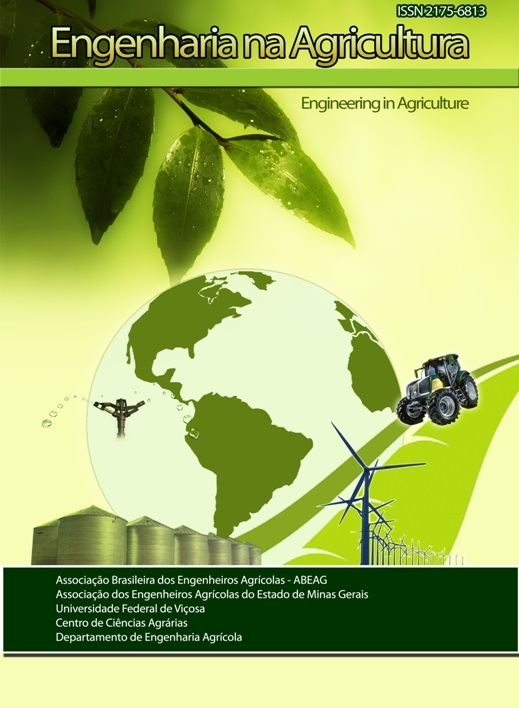Green water footprint and sustainability for espirito santo state
DOI:
https://doi.org/10.13083/reveng.v28i.970Palavras-chave:
fresh water, actual evapotranspiration, water scarcityResumo
Water footprint is a relatively new concept of freshwater appropriation that considers its direct and indirect use by a consumer or producer and used as a comprehensive indicator of the appropriation of water resources. The objective of this study was to estimate the green water footprint and evaluate its sustainability in the state of Espírito Santo, using the land use information and indicators of water scarcity. The total green water footprint was estimated by the sum of the green water footprints of pasture, forest, coffee cultivation, forestry, and other agricultural uses. The state’s total green footprint estimated was 47.5 billion m³/year, and the pasture class represented 48.5% of this total, followed by forest (29.8%), coffee cultivation (10.1%), forestry (6.4%), and other crops (5.2%). The ratio between the mean annual total volume of precipitated water and the green WF in the state was 80%. The environmental sustainability assessment shows that the green footprint was unsustainable for most of the year, on average, mainly in the May to September.
Downloads
Referências
ALLEN, R.G.; PEREIRA, L.S.; RAES, D.; SMITH, M. Crop evapotranspiration: Guidelines for computing crop water requirements. FAO Irrigation and Drainage. Paper 56, p.300, 1998.
ALVARES, C.A.; STAPE, J.L.; SENTELHAS, P.C.; GONÇALVES, J.L.M.; SPAROVEK, G. Köppen’s climate classification map for Brazil. Meteorologische Zeitschrift, v.22, n.6, p.711-728, 2013.
ALVES, M.E.B.; MANTOVANI, E.C.; SEDIYAMA, G.C.; NEVES, J.C.L. Estimate of the crop coefficient for Eucalyptus cultivated under irrigation during initial growth. Cerne, v.19, n.2, p.247-253, 2013.
BLENINGER, T.; KOTSUKA, L.K. Conceitos de água virtual e pegada hídrica: estudo de caso da soja e óleo de soja no Brasil. Revista Recursos Hídricos, v.36, n.1, p.15-24, 2015.
CASTRO, F.S.; PEZZOPANE, J.R.M.; CECÍLIO, R.A.; PEZZOPANE, J.E.M. Uso de imagens de radar na espacialização da temperatura do ar. Idesia (Arica), v.28, n.3, p.69-79, 2010.
CECÍLIO, R.A.; SILVA, K.R.; XAVIER, A.C.; PEZZOPANE, J.R.M. Método para a espacialização dos elementos do balanço hídrico climatológico. Pesquisa Agropecuária Brasileira, v.47, n.4, p.478-488, 2012.
EMPINOTTI, V.L.; JACOBI, P.R. Novas práticas de governança da água? O uso da pegada hídrica e a transformação das relações entre o setor privado, organizações ambientais e agências internacionais de desenvolvimento. Desenvolvimento e Meio Ambiente, v.27, p.23-36, 2013.
HARGREAVES, G.H.; SAMANI, Z.A. Reference crop evapotranspiration from temperature. Applied Engineering in Agriculture, v.1, n.2, p.96-99, 1985.
HOEKSTRA, A.Y.; CHAPAGAIN, A.K.; ALDAYA, M.M.; MEKONNEN, M.M. The water footprint assessment manual: Setting the global standard, Londres: Earthscan. 2011. 191p.
LEAL, A.P.P.N.; CECÍLIO, R.A.; ZANETTI, S.S. Pegada hídrica para a bacia hidrográfica do rio Itapemirim. Scientia Agricola, v.19, n.2, p.100-113, 2018.
LIU, J.; ZEHNDER, A.J.B.; YANG, H. Global consumptive water use for crop production: The importance of green water and virtual water. Water Resources Research, v.45, n.5, p.1-15, 2009.
MEKONNEN, M.M.; HOEKSTRA, A.Y. National water footprint accounts: the green, blue and grey water footprint of production and consumption, Value of Water Research Report Series No. 50, UNESCO-IHE, Delft, the Netherlands. 2011a. 44p.
MEKONNEN, M.M.; HOEKSTRA, A.Y. The green, blue and grey water footprint of crops and derived crop products. Hydrology and Earth System Sciences, v.15, n.5, p.1577-1600, 2011b.
MIRANDA, F.R.; RENATA, A.; GOMES, M.; HENRIQUE, C.; OLIVEIRA, C. Evapotranspiração e coeficientes de cultivo do coqueiro anão-verde na região litorânea do Ceará. Revista Ciência Agronômica. v.38, n.2, p.129-135, 2007.
PEREIRA, A.R.; ANGELOCCI, L.R.; SENTELHAS, P.C. Agrometeorologia: Fundamentos e Aplicações Práticas. Lavras: Agropecuária, 2002. 478p.
SCHYNS, J.F.; HOEKSTRA, A.Y.; BOOIJ, M.J. Review and classification of indicators of green water availability and scarcity. Hydrology and Earth System Sciences, v.19, n.11, p.4581-4608, 2015.
SILVA, K.R.; CECÍLIO, R.A.; XAVIER, A.C.; PEZZOPANE, J.R.M.; GARCIA, G.O. Interpolação espacial da precipitação no Estado do Espírito Santo. Floresta e Ambiente, v.18, n.4, p.417-427, 2011.
SILVA, V.P.R.; ALEIXO, D.O.; DANTAS NETO, J.; MARACAJÁ, K.F.B.; ARAÚJO, L.E. Uma medida de sustentabilidade ambiental: pegada hídrica. Revista Brasileira de Engenharia Agrícola e Ambiental, v.17, n.1, p.100-105, 2013.
THORNTHWAITE, C.W.; MATHER, J.R. The water balance. Centerton, NJ: Drexel Institute of Technology – Laboratory of Climatology, 1955. 104p. (Publications in Climatology, vol. VIII, n.1).
VANHAM, D.; BIDOGLIO, G. A review on the indicator water footprint for the EU28. Ecological Indicators, v.26, n.2013, p.61-75, 2013.
XAVIER, A.C.; KING, C.W.; SCANLON, B.R. Daily gridded meteorological variables in Brazil (1980-2013). International Journal of Climatology, v.36, n.6, p.2644-2659, 2016.
ZANETTI, S.S.; DOHLER, R.E.; CECÍLIO, R.A.; PEZZOPANE, J.E.M.; XAVIER, A.C. Proposal for the use of daily thermal amplitude for the calibration of the Hargreaves-Samani equation. Journal of Hydrology, v.571, p.193-201, 2019.
Downloads
Publicado
Como Citar
Edição
Seção
Licença
Copyright (c) 2020 REVISTA ENGENHARIA NA AGRICULTURA - REVENG

Este trabalho está licenciado sob uma licença Creative Commons Attribution-NonCommercial 4.0 International License.
Autores que publicam nesta revista concordam com os seguintes termos:
O(s) autor(es) autoriza(m) a publicação do texto na da revista;
O(s) autor(es) garantem que a contribuição é original e inédita e que não está em processo de avaliação em outra(s) revista(s);
A revista não se responsabiliza pelas opiniões, ideias e conceitos emitidos nos textos, por serem de inteira responsabilidade de seu(s) autor(es);
É reservado aos editores o direito de proceder a ajustes textuais e de adequação às normas da publicação.
A partir da submissão, o autor estará cedendo integralmente seus direitos patrimoniais da obra à publicação, permanecendo detentor de seus direitos morais (autoria e identificação na obra) e de acordo com a Licença Creative Commons, CC BY-NC.








 Esta obra está licenciada com uma Licença
Esta obra está licenciada com uma Licença 